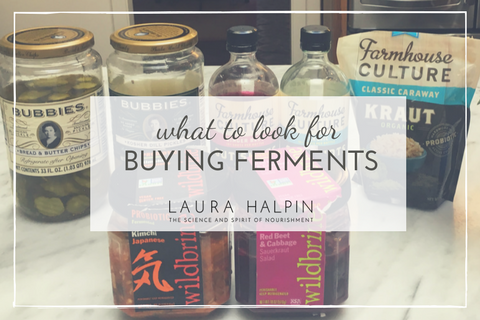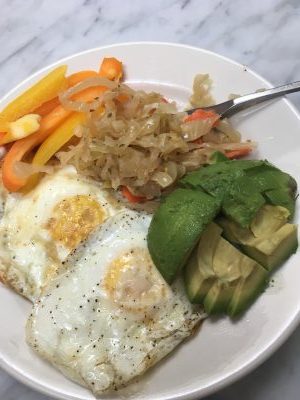
Quick How-To: What to look for when buying ferments
Although I'm totally into it, I don't assume that everyone has an interest in making his/her own fermented vegetables. Even though I make my own, there are many occasions when I purchase fermented veggies at the grocery store. Perhaps you do too.
The video below gives you a quick run-down of what to look for when purchasing your ferments.
Why eat fermented veggies, anyway?
Sauerkraut and other fermented vegetables are known as lactic acid ferments. All lacto-fermented foods have different strains or ratios of lactic-acid bacteria, and each of them is crucial for a robust microbiome and robust health.
Talk about super foods!
Fermented veggies are good us in a boatload of ways:
- They help control inflammation. Gut bacteria regulate how much inflammation there is in the body. A healthy and balanced microbiome limits the production of inflammatory chemicals in the body and brain. Inflammation is the foundation of chronic diseases like Alzheimer's and dementia, cancer, cardiovascular disease and even depression.
- The probiotics in the ferments improve digestive function. Probiotics in our foods help reduce symptoms of irritable bowel syndrome, and bloating and help maintain the integrity of the intestinal wall, preventing leaky gut.
- The beneficial probiotics in fermented veggies help increase and regulate the body's NK ("natural killer") cells that take action against food allergy reactions and fight infections.
- Ferments help serve as natural antibiotics, antivirals and anti-fungals.
- Sauerkraut contains an amino acid called choline, which is needed for the proper transmission of nerve impulses from the brain throughout the central nervous system. Within the context of digestion, these nerve impulses increase the movement of the bowel, reducing constipation.
- Lactic acid is a natural preservative that inhibits harmful bacteria growth.
- When it comes to sauerkraut, cabbage is a cruciferous vegetable, which contain phytochemicals that have anti-cancer properties.
You just gotta start eating them if you're not already.
A word or two about HOW.
A word of caution: start slowly. More doesn't necessarily mean better. When you add probiotic foods, keep in mind that you're adding a good gang to a microbiome neighborhood that is potentially overrun with bad gangs. To avoid the digestive upset that happens when the bad gangs die off, start with just a tablespoon or so and build up gradually.
Fermented foods have traditionally been used as a condiment. Think of miso soup when you eat at a Japanese restaurant. It's always present, but it's not a main course. Incorporate them into your diet in the same manner.
Ultimately, we want to be ingesting ferments on a daily basis at each meal. Work up initially to two forkfuls a day, then gradually work up to 1/4 to 1/2 cup of fermented veggies at each meal.

This is a picture of the breakfast I ate this morning. Two eggs, some diced veggies, half an avocado and a good 1/2 cup of homemade sauerkraut. I was satisfied until lunchtime without any dip in moods, attention or energy.
Whenever I eat something savory, I most often add a serving of fermented veggies to the plate. I also use ferments as a way to add flavor to meals that need some oomph.
I'd love to hear from you in the comments below:
- what are your favorite store-bought ferments (give us brand and flavor too)?
- how have you incorporated them into your diet?
- any problems or obstacles to eating ferments?




Very informative video, thanks Laura!
Still having difficulty making ferments. Is there room in your August 28 class?
If so, what time and how much?
Thanks Laura, the video was really helpful. 🙂
Hi Pauline! There is room in both the morning and evening class. Cost is $75. Would love to have you join us!
You are very welcome.
I’m glad you watched. Georgie would love some to go along with his BBQ!
Thanks Laura – Very informative